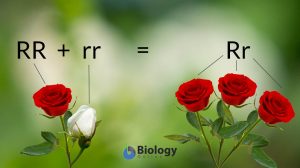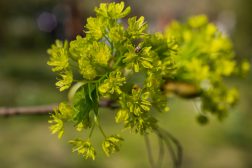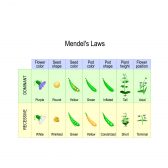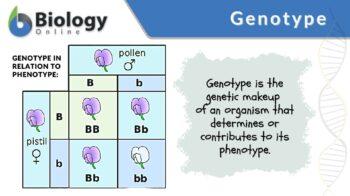
Genotype
n., plural: genotypes
[ˈdʒiːn.oʊ.taɪp]
Definition: the genetic makeup that codes for a trait
Table of Contents
Genotype Definition
Genotype is the genetic makeup of an individual cell or organism that determines or contributes to its phenotype. The contrasting terms genotype and phenotype are used to define the characteristics or traits of an organism. The genotype identifies the alleles related to a single trait (e.g. Aa), or to a number of traits (e.g. Aa Bb cc). The term can be extended to refer to the entire set of genes of an organism (or a taxon). At this comprehensive level, it overlaps somewhat with the term genome, which refers to all of the DNA in an organism. However, not all DNA consists of genes. To fully write out an organismal genotype would require a set of characters representing the alleles for each of the 20,000 or so known genes in the human genome.
What a fun way to learn! Come and join us in our Forum discussion: What is the key to the recognition of codominance?
The phenotype of an organism describes the physical or physiological features of an organism and is the consequence of the expression of the genotypes. However, the genotype is not the only factor that will determine an individual’s phenotype. Various environmental factors also have a role, and these influence the expression of the genes to determine the distinctive phenotype of an organism.
Genes, Genotypes, and Alleles
In most eukaryotes, genes come in pairs called alleles. The paired alleles will occupy the same spot on a chromosome (called a locus). They will also control the same trait. The term allele refers to a variant of a specific gene. Because most eukaryotes reproduce sexually, each parent contributes one of the two alleles for a given gene. Since each parent is the product of a different lineage of organisms, random replication errors and environmental interactions with the DNA have resulted in different modifications of the genes of each parent. This difference is the basis for the term “allele” (allo = other) which implies otherness or difference.
If the trait follows a simple Mendelian pattern of inheritance, then one of the alleles will be expressed while the other will not. The allele that is expressed is said to be the dominant allele whereas the allele that is not is described as recessive. In instances wherein the dominant allele is absent, the expression of the recessive allele will occur.
If the dominant allele is labeled as “A” and the recessive allele, “a”, three different genotypes are possible: “AA”, “aa”, and “Aa”. The term “homozygous” is used to describe the pairs “AA” and “aa” because the alleles in the pair are the same, i.e. both dominant or both recessive. In contrast, the term “heterozygous” is used to describe the allelic pair, “Aa”. The dominant trait will be expressed in the phenotypes of individuals with genotypes AA or Aa, while the recessive phenotype will be expressed in individuals with genotype aa.
Not all traits are determined by a single gene; many genes have multiple allelic variants and not all gene pairs have a simple dominant/recessive relationship. Codominance, incomplete dominance, and polygenic inheritance are examples of a non-Mendelian type of inheritance. In humans, many of the observable traits are non-Mendelian. Height and skin color, for example, are brought about by the interactions of not just a pair of alleles but of genes at several different loci.
Learn codominance and incomplete dominance with us! Join our Forum: What is the key to the recognition of codominance? Share your thoughts!
Predicting Simple Genotypes: Punnett Squares
In simple genotypes, the alleles for only one or a few traits are specified. For example, the genotype for the gene that determines the color of the pea flower is represented by two alleles, B and b. “B” is the dominant allele whereas “b” is the recessive allele. The dominant allele codes for the purple flower trait whereas the recessive allele codes for the white flower trait. See the chart picture below.
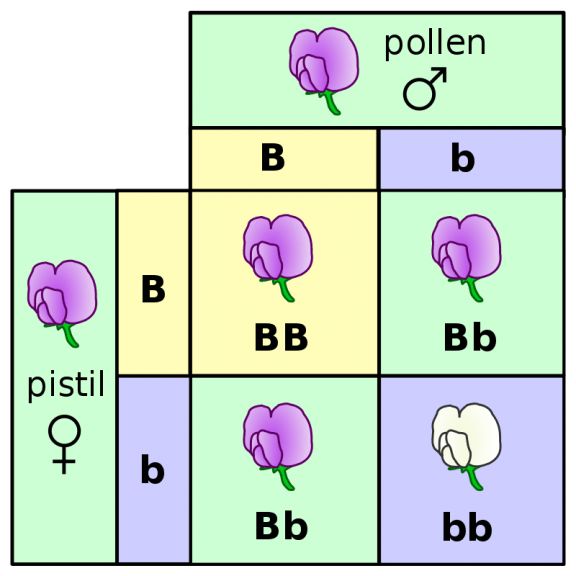
This diagram is an example of a Punnett square, first introduced by Reginald Punnett after the rediscovery of Mendel’s work. The Punnett square is an essential tool in genetics to predict inheritance patterns and ratios. This square depicts both the genotype and the phenotype of the progeny of two heterozygous (Bb) parents, both with purple flowers. In the diagram, the alleles present in the parental gametes and in the progeny produced by various combinations of those gametes are represented. Each parent produces two kinds of gametes (B and b), which are combined in all possible pairs. Of the four progeny, two are homozygous, one purple (BB) and one white (bb), and two are heterozygous (Bb), both expressing the dominant trait purple. This gives us the 3:1 phenotypic ratio of dominant: recessive phenotypes described by Mendel. It also gives us the 1:2:1 genotypic ratio of BB, Bb, and bb genotypes.
Reviewed by: Mary Anne Clark, PhD
Got questions on genotype? Join our Forum: What is the key to the recognition of codominance? Our community might be able to help!
Take the Genotype Biology Quiz!
Tutorials
References
- Comparative Genomics Fact Sheet. (2019). Genome.Gov. https://www.genome.gov/about-genomics/fact-sheets/Comparative-Genomics-Fact-Sheet
- genotype | Learn Science at Scitable. (2014). Nature.Com. https://www.nature.com/scitable/definition/genotype-234/
- Genetics Home Reference. (2020). What is a gene? Genetics Home Reference. https://ghr.nlm.nih.gov/primer/basics/gene
©BiologyOnline. Content provided and moderated by BiologyOnline Editors.

